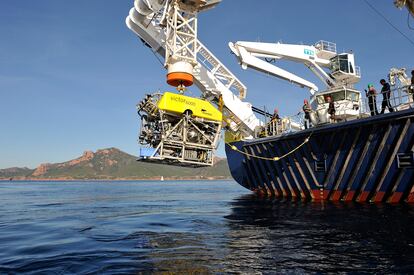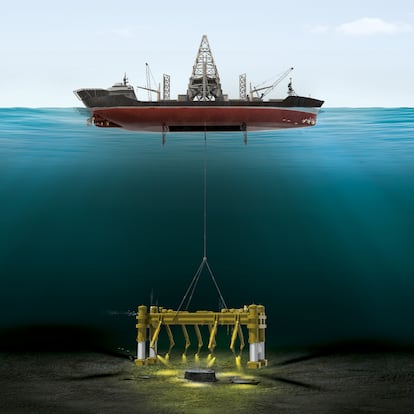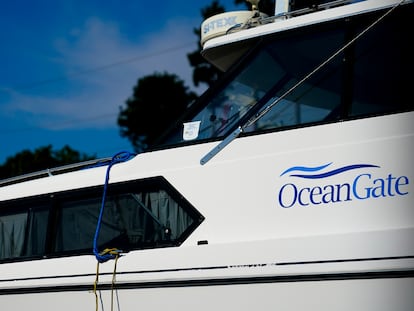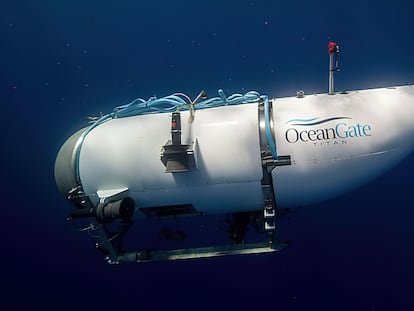How to rescue a submarine: A challenge for today’s technology that CIA spies accomplished 50 years ago
A recent scientific study delves into the details of the secret operation in which the U.S. refloated part of a Soviet missile launcher, which was sunk at the bottom of the Pacific Ocean

In the midst of the Cold War, the Soviet K-129 missile submarine sank on March 8, 1968. It was found at a depth of almost 5,000 meters (3.1 miles), in the middle of the Pacific Ocean, at an undisclosed point between the Kamchatka Peninsula and the Hawaiian Islands. The CIA took advantage of that remote location in international waters, very close to the 180th meridian that marks the international date line, to mount one of the most complex, sophisticated and expensive secret operations of the time, at the height of tensions between the 20th century’s two major superpowers. Many details of that enormous technological challenge have not been declassified and have reawakened the interest of both science fiction readers and underwater robotics researchers, especially after the Titan submersible accident last June.
In 1974, the U.S. completed its covert operation and recovered a portion of the submersible and the bodies of six divers who were aboard, all thanks to the construction of a ship with the world’s largest manipulator arm. In his latest novel, Three Miles Down, renowned science fiction author Harry Turtledove takes up the story of the submarine rescue and contrasts the robotics of the 1970s with those of today, according to a recent article published in the journal Science Robotics. “Robotics is the only rescue possibility for these situations,” reveals Robin R. Murphy, the author of the analysis and a professor at Texas A&M University.
In order to recover the lost Soviet submarine, the K-129, the CIA secretly built a ship called the Hughes Glomar Explorer. Ostensibly, it was a commercial mining vessel owned by billionaire Howard Hughes, and in theory, it was designed to extract manganese nodules from the ocean floor. But that was just a cover story. In his novel, Turtledove gives it an additional twist: the recovery of the submarine is a way to cover up the rescue of an alien spacecraft that had collided with the K-129.
Both in fiction and in reality, the vessel featured a drilling rig, a giant robotic claw mounted on the end of a five-kilometer-long pipe — called a strong-back — and a central berthing well to store the submarine once rescued. According to the recent scientific paper, in addition to pushing the boundaries of mechanical construction, the project also pushed the limits of offshore drilling technology. “Strong-back is the term used to refer to the tubes connecting the drill to the ship or platform on the surface. The limits were exceeded because of the pipe’s extraordinary length and because the Hughes Glomar Explorer was moving with the wind and waves as the underwater current moved the pipe,” Murphy explains.
Murphy’s analysis shows how the 1974 computer system was key to the mission’s success for two reasons. First, because the ship had to remain static in the ocean, taking into account changes in the sea state without an accurate satellite positioning system like today’s GPS. And second, because it had to be able to locate the position of the grapple (called Clementine) and compensate for the pipeline’s deformation by currents. Engineers created a complex system of buoys, hydrophones and sonars to measure waves, winds and currents.
Today’s technological development is much better: you only have to compare your current phone with the prototypes that existed in the early 1970s, explains engineer Ivan Masmitja, of the Institute of Marine Sciences (ICM). Today’s iPhones have a 3-gigahertz microprocessor, a speed 600 times faster than the computers that controlled the Clementine claw. “Underwater control, positioning and location systems have changed a lot. We have autonomous robots piloted by artificial intelligence [that are] capable of navigating and locating objects underwater. ROVs (remotely operated vehicles) can transmit HD and 4K images, which greatly improves exploration,” he says.

The search operation for the Titan, the Ocean Gate Company submarine that disappeared last June with five tourists aboard en route to see the Titanic, used the French remotely operated vehicle (ROV) Victor 6000, which is capable of studying and exploring the ocean. The ROV is connected by a cable to a ship on the surface (much like an umbilical cord), where pilots have direct access to the instruments and cameras, Masmitja explains. Because of its configuration, it cannot tow heavy weights, like a submersible, but it can attach a cable to the submarine or the device to be lifted. Then, it is hoisted aboard with the ship’s winch. Masmitja likens the process to “when fishing boats haul and lift large nets.”
While attempting to raise the K-129 to the surface during the rescue operation, a section of the submersible broke off and fell to the ground, as the CIA revealed in a very generic version of the Azorian project report, from which numerous details are redacted. The recent scientific paper asks whether the sinking was because of a failure in the claw toes or the craft’s loss of structural integrity at extreme depths, as Clyde Burleson argues in his book on the covert operation. According to Murphy, the latter is what happened to the Titan submersible. Antonio Crucelaegui, the director of the School of Naval Engineering at the Polytechnic University of Madrid in Spain, explains that the compression of the structure is caused by high pressure: “On the Titan, it was equivalent to having 10 buildings like the Empire State Building, each weighing 375,000 tons, on top of it. That same weight is what explains the implosion,” he points out.
Despite marine technology’s complexities and dangers, Project Azorian recovered the remains of several Soviet sailors, who were later buried at sea, as revealed by the CIA after the true purpose of the Hughes Glomar Explorer was leaked in the press. In the recent Titan case, in June the U.S. Coast Guard reported the discovery of possible human remains among the remnants of the submersible. Both cases highlight the value of robotics in enabling humans to operate in such extreme environments. According to Robin R. Murphy’s analysis, marine robotics is the only way to recover a sunken submersible, both in our own reality and in the alternative reality where the real objective is to rescue alien spacecraft from the deep ocean.
Sign up for our weekly newsletter to get more English-language news coverage from EL PAÍS USA Edition
Tu suscripción se está usando en otro dispositivo
¿Quieres añadir otro usuario a tu suscripción?
Si continúas leyendo en este dispositivo, no se podrá leer en el otro.
FlechaTu suscripción se está usando en otro dispositivo y solo puedes acceder a EL PAÍS desde un dispositivo a la vez.
Si quieres compartir tu cuenta, cambia tu suscripción a la modalidad Premium, así podrás añadir otro usuario. Cada uno accederá con su propia cuenta de email, lo que os permitirá personalizar vuestra experiencia en EL PAÍS.
¿Tienes una suscripción de empresa? Accede aquí para contratar más cuentas.
En el caso de no saber quién está usando tu cuenta, te recomendamos cambiar tu contraseña aquí.
Si decides continuar compartiendo tu cuenta, este mensaje se mostrará en tu dispositivo y en el de la otra persona que está usando tu cuenta de forma indefinida, afectando a tu experiencia de lectura. Puedes consultar aquí los términos y condiciones de la suscripción digital.
More information
Archived In
Últimas noticias
James Cameron: ‘For the films I like to make to continue to exist, we have to find a way to make them cheaper’
Families demand repatriation of bodies of Colombians who died in Ukraine: ‘This war is a slaughterhouse for foreigners’
The guardians of the meteorites of the Argentine Chaco
Helen Levitt, the photographer who captured the theater of the everyday
Most viewed
- Christian Louboutin: ‘Young people don’t want to be like their parents. And if their parents wear sneakers, they’re going to look for something else’
- US sanctions against jailed cartel leader ‘El Marro’ highlight Mexico’s lack of control over its prisons
- Cartels in Mexico take a leap forward with narco-drones: ‘It is criminal groups that are leading the innovation race’
- Liset Menéndez de la Prida, neuroscientist: ‘It’s not normal to constantly seek pleasure; it’s important to be bored, to be calm’
- ‘El Limones’ and the growing union disguise of Mexican organized crime











































